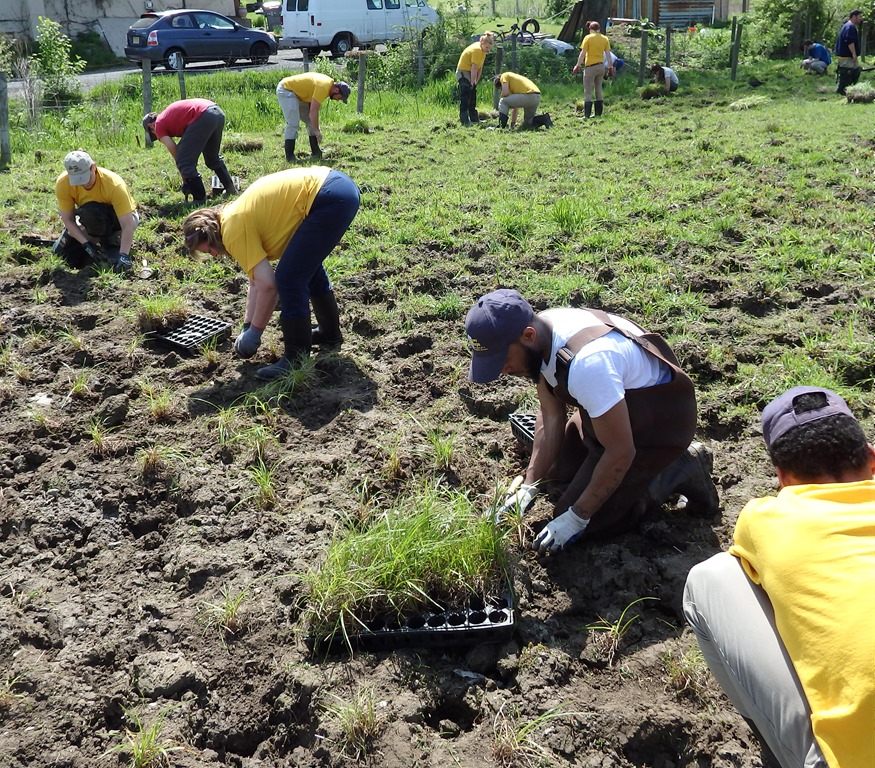CONSERVATION PARTNERS HELP IMPROVE YOUR WATER QUALITY IN NORTHERN NEW JERSEY
Originally published on New Jersey Audubon website, 5/23/16, John Parke
Free native plants and labor were the words of the day last week as New Jersey Audubon (NJA), the Sussex County Municipal Utilities Authority/Wallkill River Watershed Management Group (SCMUA-WRWMG) and the NJ Youth Corps of Phillipsburg partnered up to work with private landowners in the Highlands region to restore habitat and improve water quality.
With funding associated with the Delaware River Watershed Initiative from the William Penn Foundation and the National Fish and Wildlife Foundation the groups worked together and planted over 10,000 native plants along streams at farms in the region at no cost to the landowners.
“The type of plant we are using is dark green bulrush,” said John Parke, Stewardship Project Director of New Jersey Audubon. “Not only is the dark green bulrush a native plant that helps prevent soil erosion when planted along the banks of a stream and provides important food and cover for wildlife, but dark green bulrush helps remove phosphorus on the order of 80% from water.”
Excess phosphorus is a major part of nutrient pollution, which according to the US EPA, is “one of America’s most widespread, costly and challenging environmental problems.” Although, phosphorous is a natural and essential part of ecosystems, too much can pollute the water by leading algae to grow faster than ecosystems can handle. Excess algae can harm water quality by decreasing the oxygen that fish and other aquatic life need to survive. Additionally significant increases of algae in our water can also impact human health, food resources, and thus impact a region’s economy.
“The restoration work day conducted by NJ Audubon, SCMUA-WRWMG, and the New Jersey Youth Corps successfully created a new chapter for the awesome conservation and stewardship story that continues to grow at farms like the Jorittsma Farm and Summer Solstice Farm in the Delaware River Watershed,” said, Nathaniel Sajdak, Watershed Director with the Sussex County Municipal Utilities Authority /Wallkill River Watershed Management Group. “With NJ Audubon bringing in the NJ Youth Corps as an on-call labor force for the initiative and knowing that the students are trained in the Waders in the Water program and have experience in on-the ground conservation work, it gives us another tool in the toolbox to get the work done efficiently, cost effectively and move the initiative forward,” added Sajdak.
NJ Audubon has recently partnered with NJ Youth Corps of Phillipsburg and is providing the Corps with service learning projects in support of the Delaware Watershed Restoration Initiative. These are projects conducted in partnership with landowners and farmers in three sub-watersheds of the Highlands region: the Lower Musconetcong, Lopatcong and Upper Paulin’s Kill. These projects will help the overall watershed initiative, increasing the pace of project implementation in the field, and the projects will also provide Corps members with valuable employment skills.
“Working on farms in the Delaware River region has been challenging,” said NJ Youth Corps Member, Stacy Leisner (Age 21). “But it means a lot to me, because I’m one of those people that love animals and the environment, and I want to do what I can to make those habitats and the water better. I don’t want to see our environment go down the drain.”
NJ Audubon and SCMUA-WRWMG are looking to engage more landowners for enrollment into the various federal conservation cost share programs for conducting conservation practices on their land, as well as distribute more free native plant materials. However to be eligible to receive free pant materials properties must be located in the following sub-watersheds of the Highlands region (the Lower Musconetcong, Lopatcong and the Upper Paulin’s kill sub-watersheds) and must exhibit a degree of ecological impairment. For more information please contact NJA Stewardship Project Director, John Parke at john.parke@njaudubon.org or SCMUA-WRWMG Watershed Director Nathaniel Sajdak nsajdak@scmua.org.
What is a watershed? A watershed is an area of land that catches rain and snow and drains or seeps into a marsh, stream, creek, river, lake or groundwater. Homes, farms, forests, wetlands, small towns, big cities and more can make up watersheds. They come in all shapes and sizes and can vary from millions of acres to a few acres.
Photos by John Parke and Nathaniel Sajdak






































































